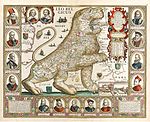Prince-Bishopric of Liège
Prince-Bishopric of Liège | |||||||||
|---|---|---|---|---|---|---|---|---|---|
| 980–1789 1791–1792 1793–1795 | |||||||||
Prince-Bishop | | ||||||||
• 340s–384 | Saint Servatius (first bishop, at Tongeren) | ||||||||
• approximately 670–700 | Saint Lambert (at Maastricht) | ||||||||
• 972–1008 | Notger (first prince-bishop) | ||||||||
• 1792–1794 | François-Antoine-Marie de Méan (last) | ||||||||
| Historical era | Lordship of Bouillon | 1096 | |||||||
• Annexed County of Loon | 1366 | ||||||||
• Acquired County of Horne | 1568 | ||||||||
| 1789–1791 | |||||||||
| 1795 | |||||||||
| accepts dissolution of Bishopric | 10 September 1801 | ||||||||
| |||||||||
| Today part of | Belgium France Germany Netherlands | ||||||||
| History of Belgium |
|---|
 |
The Prince-Bishopric of Liège or Principality of Liège
The bishops of
From 1500, the prince-bishopric belonged to the
It briefly became a republic (the Republic of Liège) from 1789 to 1791, before reverting to a prince-bishopric in 1791. The role of the bishop as prince permanently ended when the state was annexed by France in 1795. In 1815 the territories it had held became part of the United Kingdom of the Netherlands, and in 1830 they were within the part of that kingdom which split off to become Belgium.
The principality ruled by the bishops of Liège was never part of the Seventeen Provinces or the Spanish and Austrian Southern Netherlands, but from the 16th century onwards its politics were strongly influenced by the dukes of Burgundy and later the Habsburgs.
In 1559 its 1,636 parishes were grouped into eight archdeaconries, and twenty-eight councils, chrétientés (deaneries). The most important cities (bonnes villes) of the bishopric were: Liège, Beringen, Bilzen, Borgloon, Bree, Châtelet, Ciney, Couvin, Dinant, Fosses-la-Ville, Hamont, Hasselt, Herk-de-Stad, Huy, Maaseik, Peer, Sint-Truiden, Stokkem, Thuin, Tongeren, Verviers, Visé and Waremme.
The city of
Medieval prince-bishopric
The large diocese of the medieval bishops was, until 1559, much larger than the princedom which was in their possession. However, the princely domain was gradually enlarged by donations and by acquisitions. In the 10th century, the bishops received
Throughout the Middle Ages, the prince-bishopric was further expanded with the
Notger, the founder of the principality, also rebuilt the cathedral of St Lambert, as well as the episcopal palace. He was also involved in other building activities in the city, which flourished under his rule (churches of St Paul, St. John the Evangelist, Sainte-Croix and St Denis). This bishop also strengthened the parochial organization of the city. He was one of the first church leaders to spread the observance of
In the reign of
The struggles between the upper and lower classes, in which the prince-bishops frequently intervened, developed through the 13th and 14th centuries, and culminate in the 15th century in the pillage and destruction of the episcopal city. In the reign of Robert of Thourotte (1240–1246),
Burgundian and Habsburg influence


Upon the death of
Liège formed the last link in the chain of Habsburg allies that made up the so-called
Most of the bishops in the 17th century were foreigners, many of them holding several bishoprics at once. Their frequent absences gave free scope for those feuds of the
The prince-bishopric was dissolved in 1795, when it was annexed by
Timeline

Notable people
- Jean de Chokier de Surlet (1571–1656), canon lawyer and political writer
Gallery
-
The martyrdom of Saint Lambert
-
The building of Saint Martin began 965 under the reign of Heraclius
-
TheThe Morgan Library & Museum, New York City
-
PopeUrban IV, archdeaconof Liège
-
St. Lambert's Cathedraland the palace of the Prince-Bishops (18th century)
-
Portrait ofÉrard de La Marck(c. 1528)
-
The Prince-Bishopric enclaved in the Low Countries, 1556–1648
-
The perron of Liège stands as a symbol for the city rights acquired by the burghers from the prince-bishop
-
Coin perhaps from the reign of Johann Theodor of Bavaria, 1744–1763
See also
Notes
- ISBN 978-9-0272-5110-7. Retrieved 13 November 2017.
- ^ The name of the city and prince-bishopric was spelled Liége until the early 20th century and that spelling is still occasionally found in the title of old newspapers, etc. [1]
- ^ Vote number 47
- ^ Edmundson, George (1922). "Chapter II: Habsburg Rule in the Netherlands". History of Holland. Cambridge University Press. Retrieved 9 June 2007.
- ^ Parker, Geoffrey (1972). The Army of Flanders and the Spanish Road, 1567–1659: The Logistics of Spanish Victory and Defeat in the Low Countries' Wars. London: Cambridge University Press. p. 61.
References
External links
 Media related to Prince-Bishopric of Liège at Wikimedia Commons
Media related to Prince-Bishopric of Liège at Wikimedia Commons- Map of the Prince-Bishopric of Liège in 1789 (Northern part)
- Map of the Prince-Bishopric of Liège in 1789 (Southern part)












